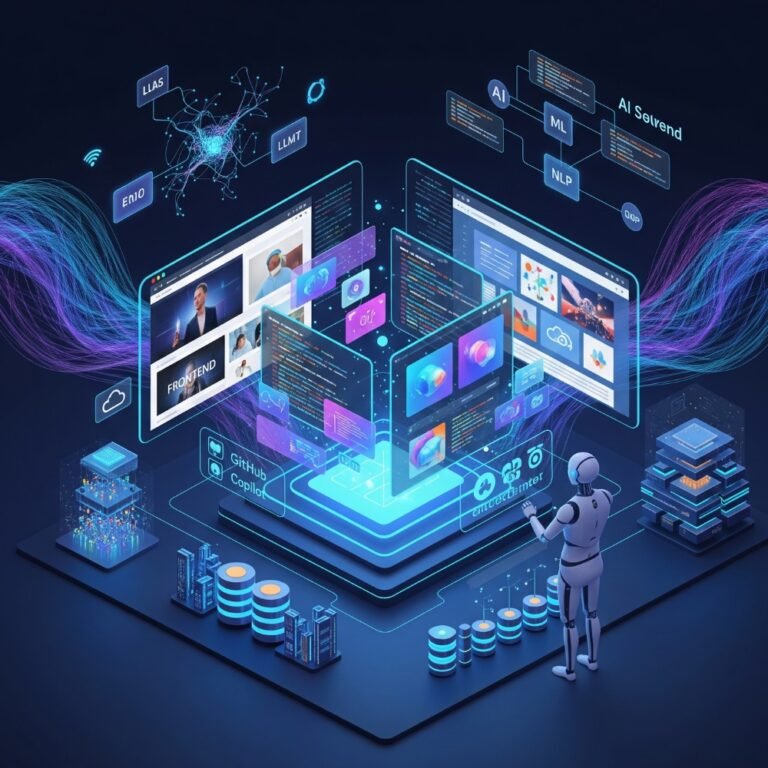Imagine a world where your Agile team runs like a well-oiled machine, with sprints planned seamlessly, backlogs prioritised without endless debates, and retrospectives delivering actionable insights in real time. That’s the promise of AI-Scrum Masters – intelligent systems that are transforming traditional Agile practices into something far more efficient and autonomous. In an era where software development demands speed and precision, especially for web projects, autonomous AI web developers are emerging as game-changers, handling everything from code generation to workflow automation. But how exactly does this work? Let’s dive in and explore how automating Agile development with AI can supercharge your team’s performance.
As a seasoned Scrum Master who’s seen countless sprints derail due to human error or miscommunication, I’ve witnessed firsthand the magic AI brings to the table. It’s not about replacing people; it’s about empowering them. Whether you’re managing a small startup or a large enterprise, integrating AI into your Agile frameworks can lead to faster deliveries and happier teams. In this article, we’ll break down the essentials, from the basics of Agile to the future of AI-driven project management, all while sprinkling in practical examples and tips.
Automating Agile Development
Agile development has been the backbone of software projects for years, but with the rise of AI, it’s evolving into something smarter and more automated. Think of it as upgrading from a manual gearbox to an automatic one – smoother rides with less effort.
What is Agile Development?
At its core, Agile development is a flexible approach to project management that emphasises iterative progress, collaboration, and customer feedback. Unlike traditional waterfall methods, Agile breaks work into short cycles called sprints, allowing teams to adapt quickly to changes. Popular frameworks like Scrum and Kanban focus on delivering value incrementally, making it ideal for dynamic fields like web development.
For instance, in building a e-commerce site, an Agile team might sprint on user authentication one week and payment integration the next, testing and refining along the way. This method promotes transparency through daily stand-ups, sprint reviews, and retrospectives, ensuring everyone stays aligned.
Why Automation is Becoming Essential in Agile Environments
In today’s fast-paced tech landscape, manual processes in Agile can bottleneck progress. Teams juggle complex tasks, from backlog grooming to burndown tracking, often leading to burnout. Automation steps in to handle the repetitive stuff, freeing humans for creative problem-solving.
Consider the data: Studies show that AI integration can reduce administrative tasks by up to 25%, as seen in companies using tools like Otter.ai for meeting notes. Why is this essential? With remote work and global teams on the rise, automation ensures consistency and real-time updates, preventing silos and delays. In Agile environments, where adaptability is key, AI provides predictive insights that keep projects on track.
How AI is Transforming Traditional Scrum and Agile Workflows
AI isn’t just a buzzword; it’s reshaping Scrum by automating key elements. Traditional workflows rely on human judgement for planning and reviews, but AI uses machine learning to analyse past data and forecast outcomes. For example, AI can predict sprint velocity based on historical performance, turning guesswork into data-driven decisions.
In practice, this means AI-Scrum Masters can facilitate virtual stand-ups, flag impediments early, and even suggest process improvements. Tools like GitHub Copilot integrate seamlessly, assisting developers with code suggestions during sprints. This transformation is particularly potent in web development, where autonomous AI web developers can generate frontend code autonomously, aligning perfectly with Agile’s iterative nature.
Understanding the Role of AI in Agile Frameworks
Diving deeper, let’s unpack how AI fits into Agile. It’s not about overhauling everything overnight but enhancing existing frameworks with intelligent assistance.
Definition of an AI-Scrum Master
An AI-Scrum Master is essentially a digital facilitator powered by artificial intelligence, designed to automate and optimise Scrum processes. Unlike a human counterpart, it operates 24/7, analysing data from tools like Jira or Trello to enforce Agile principles without bias.
Picture this: An AI-Scrum Master monitors team chats, identifies bottlenecks in real time, and generates reports automatically. It’s like having a tireless assistant that ensures ceremonies run smoothly, all while learning from each sprint to improve future ones.
Core Differences Between Human and AI-Driven Scrum Masters
Humans bring empathy and nuanced decision-making, excelling in team motivation and conflict resolution. AI, on the other hand, shines in data processing and consistency – it never forgets a deadline or miscalculates estimates.
Key differences include:
- Speed and Scalability: AI handles large datasets instantly, ideal for enterprise teams.
- Objectivity: Free from personal biases, AI provides impartial insights.
- Limitations: AI lacks emotional intelligence, so it’s best as a complement, not a replacement.
In one case, a developer built an AI-Scrum Master for Trello that automated sprint reporting, reducing manual effort significantly.
Benefits of Integrating AI into Agile Teams
The perks are plentiful. Teams see boosted productivity, with AI handling mundane tasks like backlog prioritisation. This leads to more accurate estimations and fewer overruns.
Moreover, AI fosters better collaboration by providing real-time feedback. For software development teams, especially those building web apps, AI in Agile project management means faster iterations and higher-quality outputs. As one expert notes, AI can enhance team morale by spotting trends early.
How Automation Enhances Each Agile Phase
Automation touches every corner of Agile, making phases more efficient. Let’s break it down.
Automating Sprint Planning with AI-Based Forecasting
Sprint planning often involves heated debates over story points. AI changes that by using historical data to forecast effort accurately. Tools like Zenhub’s AI sprint planning reduce noise and predict outcomes with up to 20% better accuracy.
For example, in a web development project, AI might analyse past sprints to suggest realistic timelines for UI/UX tasks.
AI-Driven Backlog Prioritisation and User Story Refinement
AI algorithms score user stories based on value, risk, and dependencies, automating what used to be manual. This ensures high-impact items rise to the top.
In practice, ClickUp AI generates SMART goals from past data, refining stories for clarity.
Automated Sprint Reviews and Retrospective Insights
AI can compile demo notes and sentiment analysis from team feedback, highlighting wins and areas for improvement. This turns retros into actionable plans without hours of discussion.
Predictive Analytics for Team Performance and Sprint Outcomes
Using machine learning, AI predicts risks like delays, allowing proactive adjustments. In large-scale projects, this can save weeks.
AI-Powered Tools for Agile Project Management
Choosing the right Scrum automation tools is crucial. Here’s a roundup of top picks.
Top Tools that Enable Agile Automation
- Jira with Atlassian Intelligence: Automates backlog prioritisation and predictive planning. Great for integrating with DevOps. Learn more about Jira AI
- ClickUp AI: Handles task generation and goal setting, ideal for AI Scrum assistants.
- Monday.com AI: Enhances workflows with custom automations, perfect for visual teams.
- Zenhub AI: Focuses on sprint planning and forecasting for GitHub users.
- Forecast: Uses AI for resource allocation in Agile environments.
These tools leverage AI for software development teams, making automation accessible.
Integrations with DevOps Pipelines and CI/CD Tools
AI tools often plug into CI/CD like Jenkins or Azure DevOps, automating deployments. For instance, GitLab’s AI transforms planning by integrating with pipelines. Azure DevOps AI Assistants
Custom AI Bots for Task Tracking and Communication
Build bots using platforms like Team-GPT for chat-based tracking, enhancing communication in distributed teams.
How to Choose the Right AI Tool for Agile Automation
Consider your team’s size, budget, and needs. Start with free trials, evaluate integrations, and check for scalability. Prioritise tools with strong machine learning in Agile features.
For more on AI project managers, check our related article: AI Project Managers in Website Development.
Real-World Applications of AI-Scrum Masters
Theory is great, but real results speak louder.
Case Studies of Companies Automating Agile Processes
A software firm using Otter.ai cut administrative time by 25%, focusing more on development. Another built a custom AI for Trello, automating reports and insights.
In web development, companies like those using GitLab AI have streamlined planning for faster site launches.
Example Scenarios: Automated Sprint Reporting, Issue Tracking, and Standups
Imagine AI generating daily stand-up summaries from Slack logs or tracking issues in Jira autonomously. These scenarios boost efficiency in autonomous AI web developers setups.
Success Metrics After Implementing AI Automation
Metrics include 20% improved estimation accuracy and 15% reduced team burnout, as per research. Teams report higher sprint velocity and on-time deliveries.
Impact of Automation on Agile Roles
Automation reshapes roles, but it’s about evolution, not elimination.
How AI Reshapes the Responsibilities of Scrum Masters and Product Owners
Scrum Masters shift to strategic facilitation, while Product Owners use AI for better prioritisation. AI handles the grunt work, letting humans focus on vision.
Collaboration Between Human Teams and AI Assistants
It’s a partnership: Humans provide context, AI delivers insights. In AI-driven teams, this leads to innovative outcomes.
Ethical and Practical Concerns in Replacing Manual Agile Oversight
Concerns include job displacement and AI biases. Ethically, ensure transparency and human oversight to maintain trust.
Benefits of Automating Agile Development
The advantages are compelling.
Increased Sprint Velocity and Team Productivity
AI streamlines processes, boosting velocity by automating routines.
Improved Accuracy in Estimations and Delivery Timelines
Predictive analytics refine estimates, reducing overruns.
Real-Time Monitoring and Feedback Loops
AI provides instant feedback, enhancing agility.
Cost and Time Efficiency for Large-Scale Projects
For big projects, AI cuts costs by optimising resources.
Challenges and Limitations
No rose without thorns.
Data Dependency and Quality Issues in AI-Driven Insights
AI needs clean data; poor quality leads to flawed predictions.
Resistance to Automation in Agile Culture
Teams may resist change, fearing loss of control. Address with training.
Over-Reliance on AI Decisions in Human-Centric Development Models
Balance is key; over-reliance can stifle creativity.
Future of AI-Scrum Masters
Looking ahead, the horizon is exciting.
Predictive Models for Self-Organising Agile Teams
AI will enable truly self-organising teams with advanced predictions.
The Role of Generative AI in Agile Documentation and Reporting
GenAI will automate docs, making reporting effortless.
Will AI Replace Human Scrum Masters? (Expert Opinions & Trends)
Experts say no – AI augments, not replaces. Trends show upskilling as key, with AI handling 30-40% of tasks by 2030. In web dev, autonomous AI web developers will collaborate with humans for complex projects.
How to Implement AI in Your Agile Workflow
Ready to start? Here’s a guide.
Step-by-Step Process to Integrate AI Tools in Agile
- Assess your current workflow for pain points.
- Choose a tool like Jira AI.
- Pilot in one sprint.
- Train the team.
- Scale and iterate.
Change Management and Team Training Strategies
Involve the team early, offer workshops, and highlight benefits to ease adoption.
Measuring ROI and Success of Agile Automation
Track metrics like velocity, defect rates, and satisfaction scores. ROI often shows in reduced time-to-market.
Best Practices for Sustainable Agile Automation
Sustainability ensures long-term success.
Balancing AI Automation with Human Decision-Making
Always have human veto power for critical choices.
Maintaining Agile Values and Principles in Automated Environments
Uphold collaboration and adaptability; AI should support, not dictate.
Continuous Improvement and Iterative Automation
Treat automation as Agile – iterate based on feedback.
FAQs
What is an AI-Scrum Master?
An AI-Scrum Master is an intelligent tool that automates Scrum tasks like planning and reporting, enhancing human efforts in Agile teams.
How does AI improve sprint planning?
AI uses data to forecast efforts and prioritise tasks, making planning faster and more accurate.
Are there risks in using AI for Agile?
Yes, including data quality issues and over-reliance, but these can be mitigated with proper oversight.
Can AI replace human Scrum Masters?
Unlikely; AI complements by handling routine tasks, allowing humans to focus on strategy and empathy.
What tools should I start with for Agile automation?
Begin with Jira AI or ClickUp for easy integration and proven results in AI in Agile project management.








